

APEX Proposal to excite Imperfection resonance on 250GeV Ramp V.Ranjbar, M. Bai, V. Ptitsyn, I. Blackeler, T. Summers, A. Marusic, G. Robert-Demolaize, K. Yip
To Prepare for APEX study of Imperfection Resonances impact on Polarization, I created A matlab program to perform DEPOL Imperfection resonance calculation. I then used this Program to perform a response matrix calculation relating correctors to the real and Imaginary part of the resonance strength. With this response matrix we can then construct a set of correctors to perturb the resonance in a precise manner. For example we constructed a new matlab function to return the corrector strengths necessary to achieve a given Delta in the imperfection resonance while keeping the surrounding resonances unperturbed. An example of how we would use this function is shown below: % load the lattice for this we are using an error free lattice but this works with a % misaligned lattice as well Blue3; % Define initial GGAMA resonance location we want to kill GGAMI = 374; % Define final GGAMA resonance location we want to kill GGAMF = 390; % The Target resonance GGAMT = 380; % the amount we want to perturb the resonance can be real and imaginary DW = 0.1 % Use my findDtheta function to return the corrector strengths theta = findDtheta(THERING,GGAMI,GGAMF,GGAMT,DW); % apply the corrector strengths to the lattice CORRV = findcells(THERING,'FamName','KICKV'); for j=1:length(CORRV) THERING{CORRV(j)}.KickAngle = THERING{CORRV(j)}.KickAngle - [0 theta(j)*1.0e-5]; end
% and now we check the results to make sure its doing what we want. So can repeat this exercise for the real and imaginary parts of the imperfection Resonances for several resonances around the main intrinsic resonance crossing At 411-NU and the other strong one at 393+NU. My initial tests have shown that The strength of the perturbation remains fairly constant with errors and scalable.
Now with these sets of correctors strength we can construct 'knobs' to turn On a given set of delta corrector strengths during the 411-NU resonance Crossing to alter the Imperfection resonance in a very controlled manner. Exciting just the real or imaginary part of the resonance. In this way we can Better evaluate the impact of these resonances on the polarization losses we believe Are occurring during both of these resonance crossings. As a cross check we can also measure the differential orbit an compare that to Our model to better understand if we are exciting the changes we desire. For example We see what the difference orbit should look like and even calculate and FFT:
The results from APEX: we tested matlab scripts to turn on and off correctors based Our calculations and plotted how the orbit responded compared to what the SXF Model predicted. At injection we excited what would be a 0.05 imperfection resonance At Ggamma = 45 and flat from 40 to 48 Ggamma. At this energy we severely distorted The orbit yielding 2.5 mm rms. However our model looked fairly similar to what we Measured on the BPMs (there were some spikes with large errors).
However if we compare the predicted orbit excursion at the stones we are Interested in gg381 then the rms= 0.16 mm an order of magnitude smaller for the same 0.05 imperfection resonance strength. We estimate that our Current resonance strength is about 0.03 so 0.05 should give us enough Room to suppress this with minimal impact on the orbit.
Blue Difference orbit at Ggamma=423 RMS predicted = 0.3622 mm Measured = 0.385 mm Vertical Tunes in model used Were far off (29.65)
Yellow Difference Orbit at Ggamma=381 Rms predicted = 0.489 mm Measured = 0.371 mm Yellow Tunes of model Better (29.68)
Polarization Response In Yellow Simulation Prediction with 0.24 Resonance strength Simulation Prediction with 0.12 Resonance strength Experiment (16635) with 0.2 resonance Average previous 4 stores
Blue Polarization Response Average of previous 4 stores Experiment (16635)
Effects of bad mu snake angle
Effects of Bad Phi snake angle
Conclusion and Plans: ● We have shown we can deploy this without loosing destroying the beam during a ramp. ● There would seem to be some effect. ● Plan to make it easy for operators to use as a future polarization optimizing knob. ● We will recalculate our theta kick values with improved optics and supply knobs to hit 380,381,382 and 422,423,424 for real and imaginary parts. ● With a lot of help from Kin Yip we have developed some scripts to pull back these polarization profile measurements. I have matlab scripts to perform a difference calculation so that this can become a routine type of analysis to guide our efforts. ● Plan on performing simulations with snakes de-tuned to see if I can reproduce some of the structure in the profiles.
Recommend
More recommend